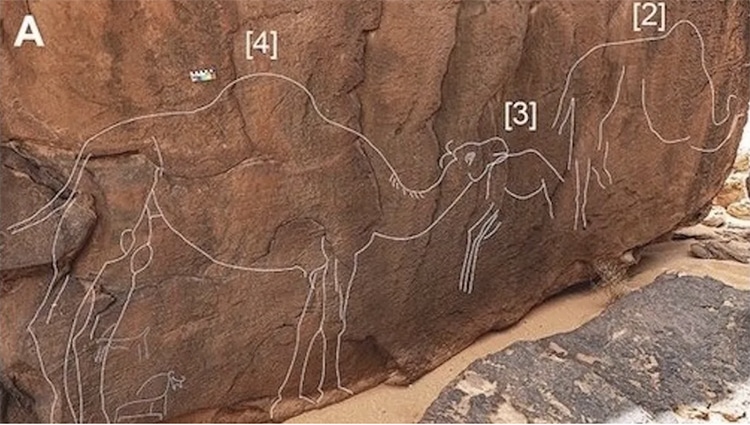
The camel carvings with virtual white outlines for ease of viewing. (Photo: Maria Guagnin et al.)
Imagine traveling through the desert of Saudi Arabia and encountering a tall reddish rock. Inside a crevice are carvings of almost a dozen camels etched in life-size proportions. This stunning artistic display is a mysterious, ancient tribute to the wild camels that once roamed the deserts of what is now Saudi Arabia. Although these etchings may pose more questions than it answers, a recent Archaeological Research in Asia paper suggests that this artwork may have held significance to early inhabitants at the southern edge of the Nefud desert.
These reliefs have been known as an archaeological gem for some time. Known as Sahout, the site is on the southern border of the Nefud desert, a vast sand dune desert that has evidence of human life stretching back at least 85,000 years. In ancient days, wild camels roamed the dunes (also America, but that’s a different story) with shaggy fur and recognizable humps. The wild camel is almost a lost legend, with the only remaining ones being the extremely endangered Bactrian camels. These magnificent beasts had such a presence in daily life in the Arabian Peninsula that enormous sculptures were crafted of them long before Stonehenge was erected.
These newly assessed reliefs are a further tribute to the camels. Numbering about 12, the reliefs are life-sized. The camels depicted appear to have been drawn during their mating season, as the are rendered with the thick fur they would later shed. “What’s most striking about the beautifully carved camels is that most of them are male,” lead author Maria Guagnin said. “Some of the carvings contain camels showing their dulla, an organ that hangs out of a male camel’s mouth [and that is used to attract females].”
But why carve a pack of feral camels into a hard-to-find rock crevice in the desert? The answer is still unclear. However, testing has revealed that Sahout was often occupied throughout ancient history: from periods as distant as the the Pleistocene (2.6 million to 11,700 years ago) to the Middle Holocene (7,000 to 5,000 years ago). Who exactly created the engravings is a mystery, especially since it overlaps with other drawings from different eras. Even so, reliefs reveal—through their similarity to other sites depicting camels—both the importance of these animals and rock art to early cultures in the region.
This pack of incredible life-sized camel engravings was carved by unknown people thousands of years ago on a large rock in the Nefud desert (modern-day Saudi Arabia).

Wild camels are shown in the carvings. (Photo: Maria Guagnin et al.)
h/t: [Live Science]
Related Articles:
Archeologists Discover ”Pizza” in an Ancient Pompeii Mural
1,900-Year-Old Ancient Roman Swords Are Found in a Cave Above the Dead Sea
5,000-Year-Old Iranian Vase Features the First Known Animation
2,700-Year-Old Petroglyphs Are Discovered Under Moss in Sweden
